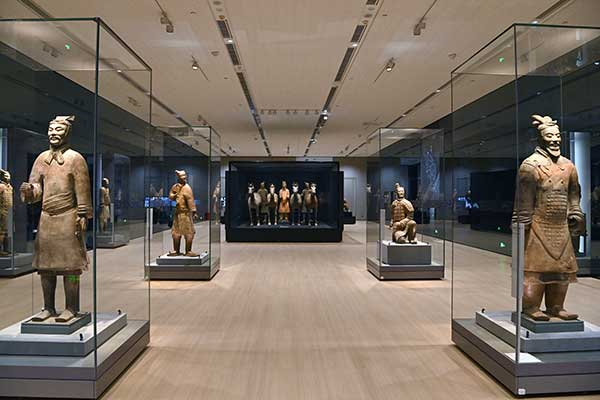
The exhibition Buried History and Mystery of China's First Emperor. [Photo provided to China Daily]
Knowing death was an inevitable issue that he had to face one day, Emperor Qinshihuang, who ended the long-term fighting and chaos among vassal states during the Warring States Period (475-221 BC) and established the Qin Dynasty (221-206 BC), the first central united dynasty, paid close attention to two important considerations during his lifetime: seeking an elixir to extend his life and building an underground realm.
The former seems to have been in vain, but the latter has left an incredible mausoleum complex where he has rested in peace for more than 2,000 years.
While the greatness of the first emperor of Chinese history is widely known, many may not have truly grasped the national strength of the Qin Dynasty solely through history books. This changed five decades ago in 1974 with the discovery and excavations of the Terracotta Warriors. These underground armies safeguarded the emperor's posthumous peacefulness and their discovery offered modern people a real sense of the prosperity of the dynasty.
Over the past 50 years, archaeologists' efforts have increased understanding of the emperor and that era, step by step.
To mark the occasion, a permanent exhibition to showcase archaeological discoveries at the mausoleum, titled Buried History and Mystery of China's First Emperor, kicked off in September at Emperor Qinshihuang's Mausoleum Site Museum, which oversees the mausoleum in Xi'an, Shaanxi province.
According to Ye Ye, deputy director of the exhibition department of the museum and curator of the exhibition, a total of 230 artifacts — among them, the most emblematic cultural relics found in the mausoleum — are on display. Notably, one-third of these artifacts are being exhibited for the first time.
"The opulent burial site of Emperor Qinshihuang's underground world reflects the material culture and spiritual ideology of Qin, with a single imperial mausoleum bearing witness to a great era," says Ye.
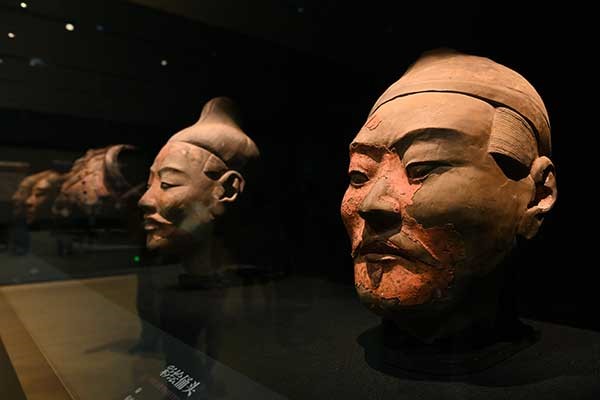
Various types of Terracotta Warriors and figurine heads are on display at Emperor Qinshihuang's Mausoleum Site Museum in Xi'an, Shaanxi province. [Photo provided to China Daily]
Grand scale
Entering the exhibition hall, visitors view a giant bronze ding caldron on their left.
Weighing 212 kilograms, this is the largest ding caldron ever discovered in the mausoleum area with complicated and exquisite patterns on its body.
"This is regarded as 'the No 1 ding of the Qin mausoleum'. Since a ding caldron symbolizes political power, we put it at the entrance to showcase the strong national strength of the Qin Dynasty," says Zhang Sheng, a researcher at the museum.
Opposite to this ding is the sand table model of the entire mausoleum site and its neighboring environment, symbolizing the region of the mausoleum, which also imitates the layout of Xianyang, the Qin capital. "In this way we show Qin's political power and its corresponding region," he adds.
Over the years, archaeologists have defined the layout of the mausoleum, which covers a stunning area of 56.25 square kilometers.
Archaeologists have discovered more than 10 aboveground building remains, found more than 500 satellite pits and tombs and unearthed more than 50,000 cultural relics, according to Ye.
"Historical literature records that the construction of the mausoleum spanned 38 years and involved the participation of 700,000 people. The grand scale and rich buried artifacts are rare across the world," says Li Gang, director of the museum.
Ye highlights the layout of the mausoleum which is designed with the mound covering the main grave at the center. It can be divided into three levels from the inside out with two city walls. The inner level covers the area within the inner city walls; the middle level lies between the inner and outer city walls; and the outer level is the area outside the outer city walls.
The inner level is the central area, containing the underground palace of the emperor, the carriages used by him and the mausoleum buildings, symbolizing the imperial palaces where the emperor lived.
The middle level includes underground counterparts of government offices, armories, imperial stables, and places for entertainment providers, as well as administrative offices for gardens and temples.
The outer level includes Terracotta Warriors representing the imperial guards, ponds for waterfowl and a city to safeguard the mausoleum.
"The overall layout of the mausoleum embodies the ancient concept of serving the dead as if they were living and the design idea of creating a replica of the capital city. It is a representation of the supreme power of Emperor Qinshihuang," says Ye.
The complete layout and locations of sites excavated within the mausoleum can be seen on the sand table at the exhibition, so that visitors can get a comprehensive understanding of where exactly the sites were discovered and their importance, says Zhang.
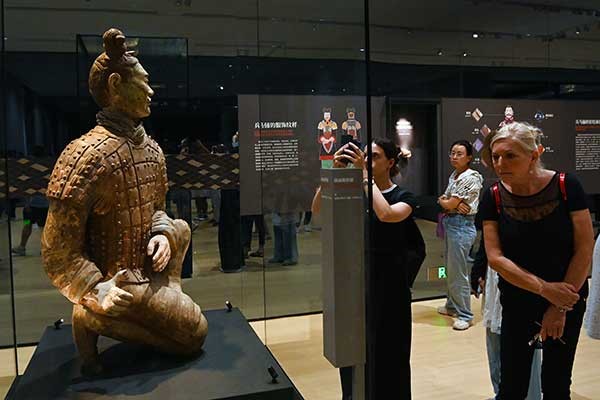
Various types of Terracotta Warriors and figurine heads are on display at Emperor Qinshihuang's Mausoleum Site Museum in Xi'an, Shaanxi province. [Photo provided to China Daily]
Unity drive
One of the biggest contributions of Emperor Qinshihuang, people generally believe, is that he established a central dynasty that united China and implemented a series of policies to consolidate unification, like the unity of words, currency and measurements according to historical literature, which then has a long-lasting influence on later dynasties in China. That can be evidenced by some unearthed artifacts.
A bronze bobweight on display has two engraved edicts of unifying measurements — one from 221 BC, the year Emperor Qinshihuang established the Qin Dynasty, and the other from 209 BC, the first year of his son's reign.
"The bobweight is about 256 grams. It was unearthed from the Siguan Site between the inner and outer walls in the west of the mausoleum. We believe it was a standard measurement to be promoted across the dynasty," says Ye.
"Unification of such things actually laid a solid foundation for the unification of China since the Qin Dynasty."
Qin implemented a rigorous management system inherited from the Spring and Autumn Period (770-476 BC). This system mandated that craftspeople engrave their names on the artifacts they produced, holding them accountable for the quality throughout their lifetimes.
Concrete evidence of the system is a bronze halberd from Terracotta Warrior No 1 Pit, which bears inscriptions confirming it was made in 242 BC by craftsman Cheng. Official Zhe and his assistant Yi from Sigong, an institute that governed weapon-making, were responsible for its quality and the production was supervised by counselor-in-chief Lyu Buwei (292-235 BC).
"Emperor Qinshihuang established a united dynasty with multiple ethnic groups and consolidated his unification with a series of political systems. Such a great cause required efficient management. This system just reflects the accuracy and efficiency of his governing," says Ye.
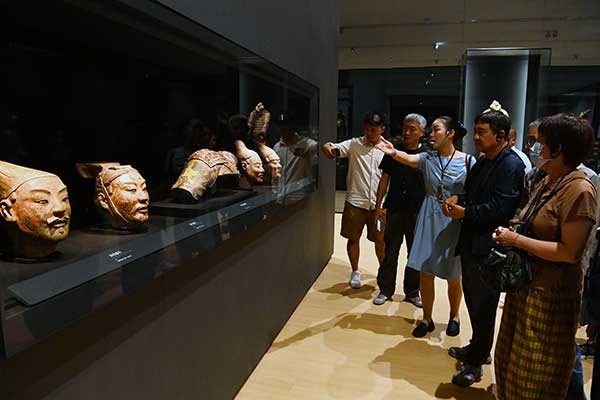
Visitors attentively listen to a tour guide as she introduces a selection of pottery figurines being exhibited. [Photo provided to China Daily]
Two ceramic acrobatic figurines just restored by experts debut at this time. One is a rare example of the acrobatic figurines found from the mausoleum with a complete head. These special figurines were unearthed from an 800-square-meter satellite pit between the inner and outer walls in the southeastern part of the mausoleum with 37 other figurines. Archaeologists believe they embody entertainment providers who performed for the emperor in his palaces.
Apart from the exhibition, an international conference was also held in September to mark the occasion, during which Li summarized the achievements of archaeologists and heritage protectors over the past decades.
"As of now, the mausoleum has received over 160 million visits from home and abroad, making it a globally renowned cultural tourist destination and a model for the protection, research and revitalization of cultural heritage," says Li.
"The precious relics and artifacts bear witness to the material culture, technological achievements and civilization before and after Qin unified China. The archaeological work has played an important role in tracing the development of Chinese civilization and showcasing its brilliant achievements."
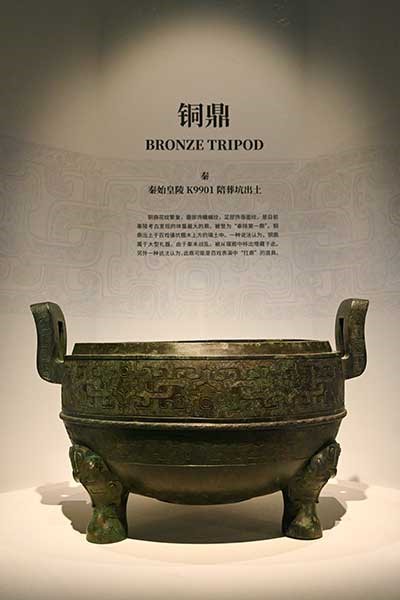
The largest bronze ding caldron unearthed from the mausoleum. [Photo provided to China Daily]